Growing up in the ‘80s, my sisters and I listened to a rap song by Run DMC that was all about Black History. We listened to that cassette tape over and over again and had it memorized. And now, decades later, I can still remember the opening:
Black, Black, Black history
Black, Black, Black history
Black history, Black history
The story of my people means a lot to me
Where you came from shouldn’t be a mystery
So listen up while I school you on Black history
From that song, I learned about Dr. Daniel Hale Williams, the first person to perform open-heart surgery. I learned about Madame CJ Walker, the first female self-made millionaire, and of Garrett Morgan, who invented the traffic light.
It was an important song for me in my childhood because it normalized Black people doing extraordinary things in everyday life. It highlighted how beneficial Black people were to society at large, even in modern times. It expanded our history beyond the horrific evils of 400 years of slavery.
Sure, I knew about other great Black leaders that are often celebrated such as Harriet Tubman and Martin Luther King, Jr., those that were instrumental in freeing enslaved people and in leading the civil rights movement in the U.S.
But this song introduced me to Black people throughout history who had a significant impact on the world as we know it. People who looked like me. People I didn’t learn about in school. That was a game-changer. One that enabled me to see what was possible for me.
Where did Black History Month come from?
In 1915, historian Carter G. Woodson and minister Jesse E. Mooreland founded the Association for the Study of Negro Life and History (ASNLH), which is known today as the Association for the Study of African-American Life and History (ASALH).
Their objective for the organization was to research and promote the achievements of Black Americans and other people of African descent.
In 1926, the organization sponsored Negro History Week. They chose to have the week in the second week of February to coincide with the birthdays of two men who had played prominent roles in shaping Black history, Frederick Douglass, whose birthday was February 14, and Abraham Lincoln whose birthday was February 12.
There had already been celebrations within the Black community for the two men since their deaths. The ASALH wanted to capitalize on traditions that already existed to extend the study of Black history beyond two great men to shine a light on the race’s achievements.
As part of the weeklong event, schools, churches, and communities across the country started planning their programs to celebrate and educate others on Black history. As Negro History Week gained popularity and Black populations grew around the country, mayors and other government officials started officially putting it on the books.
Over the years, there were calls to expand Negro History Week to a full month. By the late 1960s Black History Month replaced the previous weeklong celebration on many college campuses. Eventually, ASALH used its influence to make the change official at a national level.
Black History Month was officially recognized in 1976 by President Gerald Ford. He noted that it was a time to “seize the opportunity to honor the too-often neglected accomplishments of Black Americans in every area of endeavor throughout our history.”
Canada also celebrates Black History Month in February. In Europe, it is celebrated in October by the UK, Ireland, and the Netherlands.
Is it racist to have Black History Month?
A common objection that pops up is that it seems hypocritical to have Black History Month, but not a White History Month.
To be clear: It isn’t.
The reason we need Black History Month is the same as the reason why we need Women’s History Month, which happens in March of every year.
We don’t need White History Month because White history fills the history books and society’s narrative at disproportionate rates. White history is presented as “history.” We don’t need Men’s History Month because Men’s history fills the history books and society’s narrative at disproportionate rates. Men’s history is presented as “history.”
When the contributions of groups of people are underrepresented, as in the way that Black people and women are, it is necessary to specifically shine a light on their efforts as a form of equity.
This is also important because representation matters. Both children and adults are often able to see what is possible for them when they see others achieving who are also like them — people that look like them, have the same backgrounds as them, or even come from the same place as them.
And thus when the narrative that society at large presents excludes stories of people who are like you, it has a negative effect. When it includes stories of people who are like you, it has a positive impact.
Celebrating Black History Month isn’t racist. At the point where we are in society, it is, however, still necessary.
Why brands should celebrate Black History Month
Business is about belonging. Increasingly people want to feel like they belong with both the companies they work for and the ones they spend their money with. A big contributor to communicating belonging, particularly to diverse and niche consumer groups, is to make them feel seen.
Whenever I encounter a brand acknowledging and celebrating Black History Month, I feel seen at some level. I appreciate that the brand recognizes the importance of the many contributions of Black people around the world, and that the stories of those achievements aren’t told nearly enough.
In February this year, my mom sent a group text to me, my sisters, and some close friends. It had a photo of a display she saw upon entering a Target store near where she lives. The display was full of books of Black authors, featuring stories of Black characters. There were also other products featured that were designed by Black makers. Everyone in our group text loved it. We felt seen.
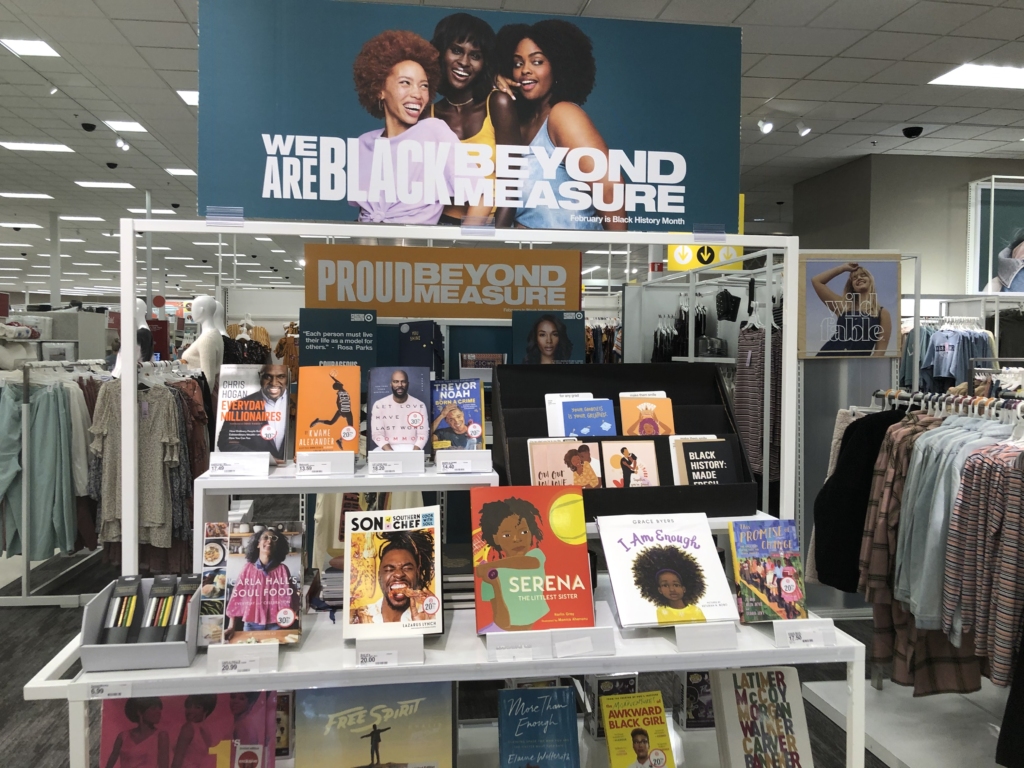
Thus if you want to make Black consumers and Black talent feel like they belong with you, you have to prove that their credit card and diversity classification aren’t the only things you care about.
Showcase that you care about the individuals your brand touches, as well as the Black community. Celebrating Black History Month in an authentic way is a smart way to do that. (Note: it shouldn’t be the only way).
Principles for celebrating Black History Month the right way
I have found it exciting to see so many brands jumping into the ring to celebrate Black History month over the past few years. It signifies that more companies are embracing diversity, inclusion, and belonging — not only internally when it comes to human resources and company culture but also in their marketing.
There isn’t just one way to celebrate Black History Month. There is a broad range of how you can structure your efforts that makes sense for your brand.
Here are some best practices for executing your Black History Month campaigns filled with good and not so great examples of the principles in action. Apply these principles for both internal and external campaigns.
Principle #1: Your campaign should be inspirational and instill a sense of pride
Black History Month is all about promoting the achievements and contributions of Black people. Thus when Black people, in particular, are engaging with your campaign, they should see themselves reflected in a positive light.
In 2015, the Washington Wizards basketball team and their parent company Monumental Sports found themselves on the receiving end of some mixed reviews from consumers who thought their Black History Month campaign was odd.
Here’s a look at a few of the images:
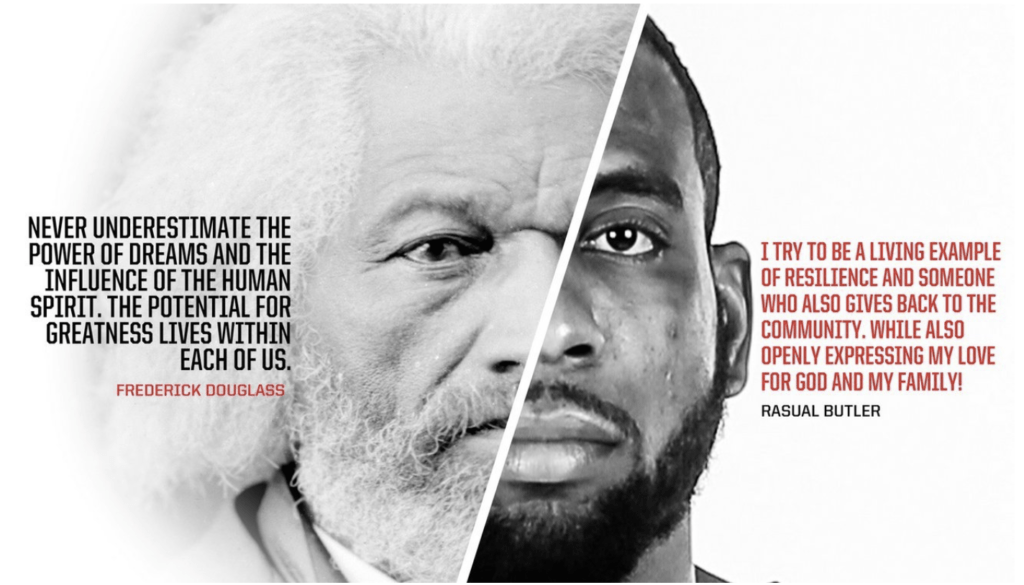
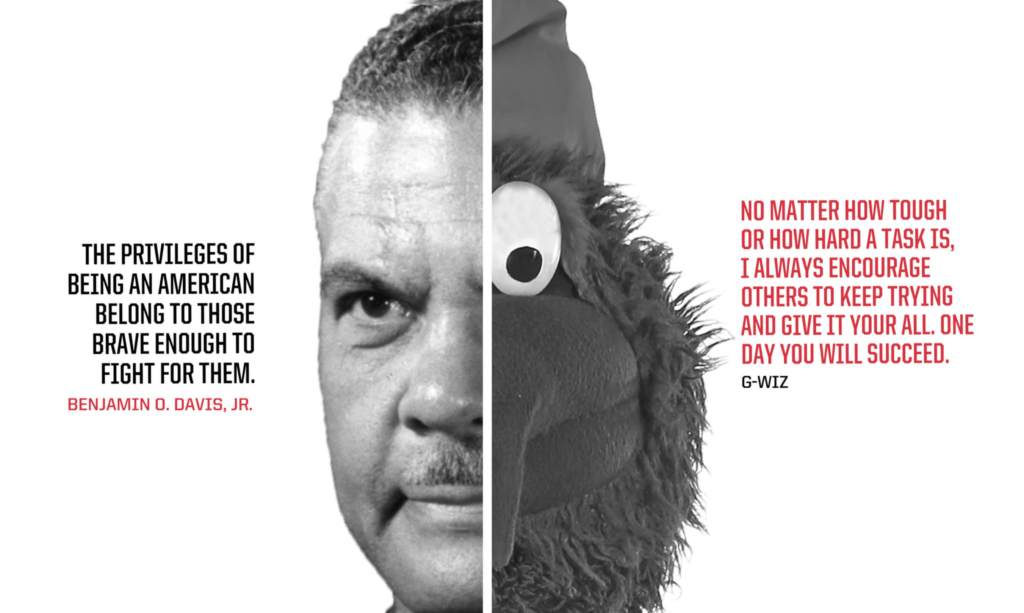
The Wizard’s posted an apology on their Facebook page in response to the comments:
“Throughout Black History Month, we ran an “Inspire” campaign. We asked a variety of Wizards, Capitals and Mystics players and staff to share who inspired them. We asked them for a favorite quotation and then created a composite image that was half the player/staff member and half the person they admired. We released one composite image a day throughout February in an attempt to honor those who our staff had identified as heroes. We intended this as a way to celebrate Black History Month and focus on the many important contributions by African-Americans to American history and culture. On a personal level, it was a way to share thoughts on African-American historical figures whom we admire. We may have missed the mark, and we apologize to those who were offended by the way this was presented.”
While there were plenty of people who appreciated the organization’s attempt to celebrate Black History Month, many were just frustrated by their execution. They thought it was sloppy and poorly executed. Thus instead of focusing on the quotes’ positive messages, people couldn’t get past what they felt was bizarre imagery.
Visual imagery is powerful. Your customers need to see themselves or who they aspire to be reflected in the imagery you put forth. In this case, customers were too put off by the mashup of images to derive a sense of pride from the message.
Contrast that with Google’s 2020 Black History Month campaign. In it, they created a montage of “the most searched” in various categories, such as performance, athlete, female poet, autobiography, speech, and more, using data from January 1, 2004, when Google search data first became available, through July 1, 2019. Of course, each of “the most searched” in the categories featured was Black.
When I watched the video, I was filled with pride and got all choked up. I’m not the only one. There were plenty of comments on social media echoing a similar sentiment.
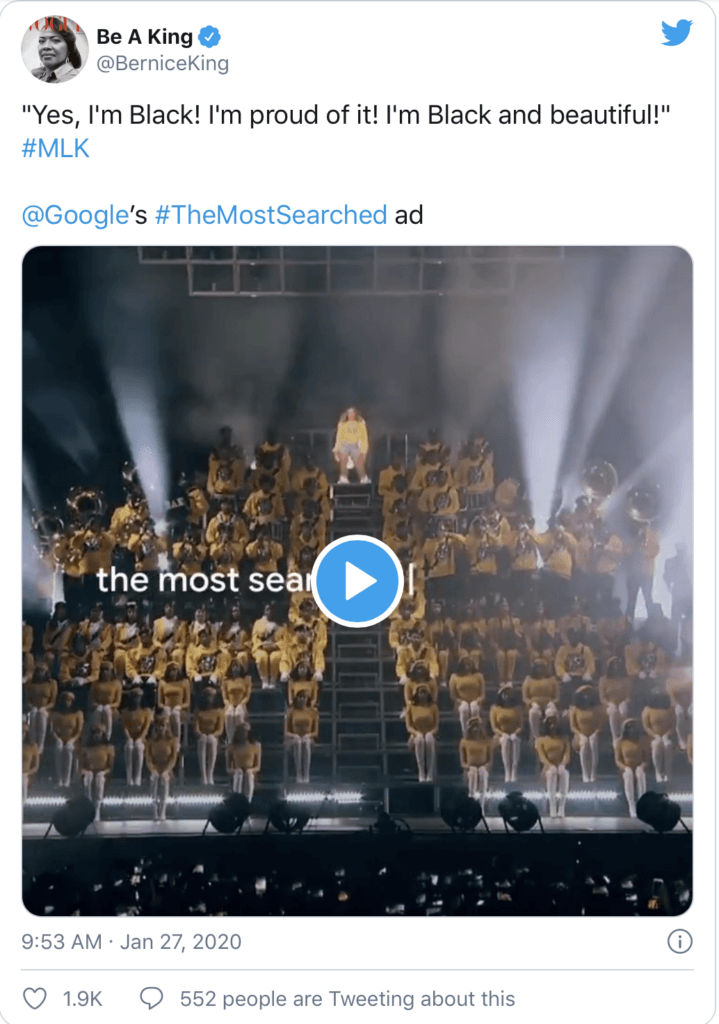
The good news is that there is an abundance of inspiring stories and facts about Black people for you to pull from as you work to create a campaign that delivers these emotions.
Principle #2: Make the Black community and culture the hero
Black History Month is a prime opportunity to shine a light on the voices, works, and achievements of people within the Black community.
Barnes & Noble lost sight of this core principle, and as a result, they ended up pulling the plug on their 2020 Black History Month campaign. The book retailer executed a plan to launch classic books such as Moby Dick, The Wonderful Wizard of Oz, and Peter Pan with redesigned covers that featured Black characters.
Backlash for the initiative was swift once news of it became public. The overwhelming sentiment was that if you want to celebrate the history and achievements of Black culture, you don’t do it by promoting works of White authors, with “reimagined covers” featuring Black faces.
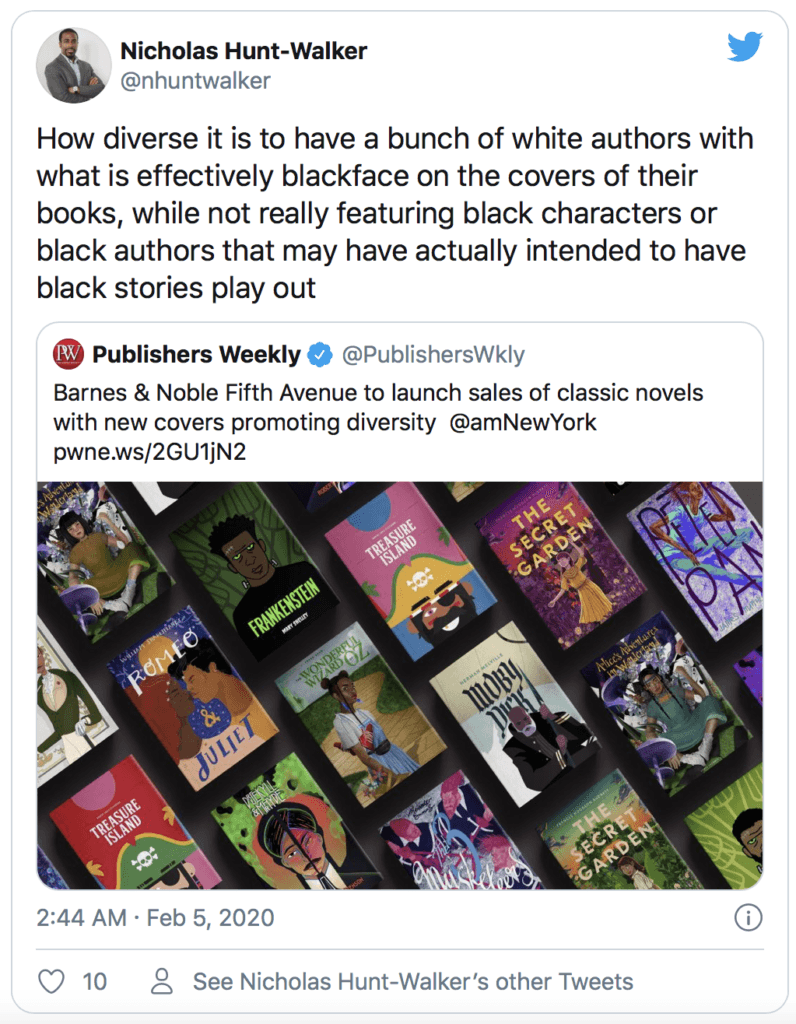
Barnes & Noble canceled the initiative before it launched and issued an official statement to explain why they pulled the program:
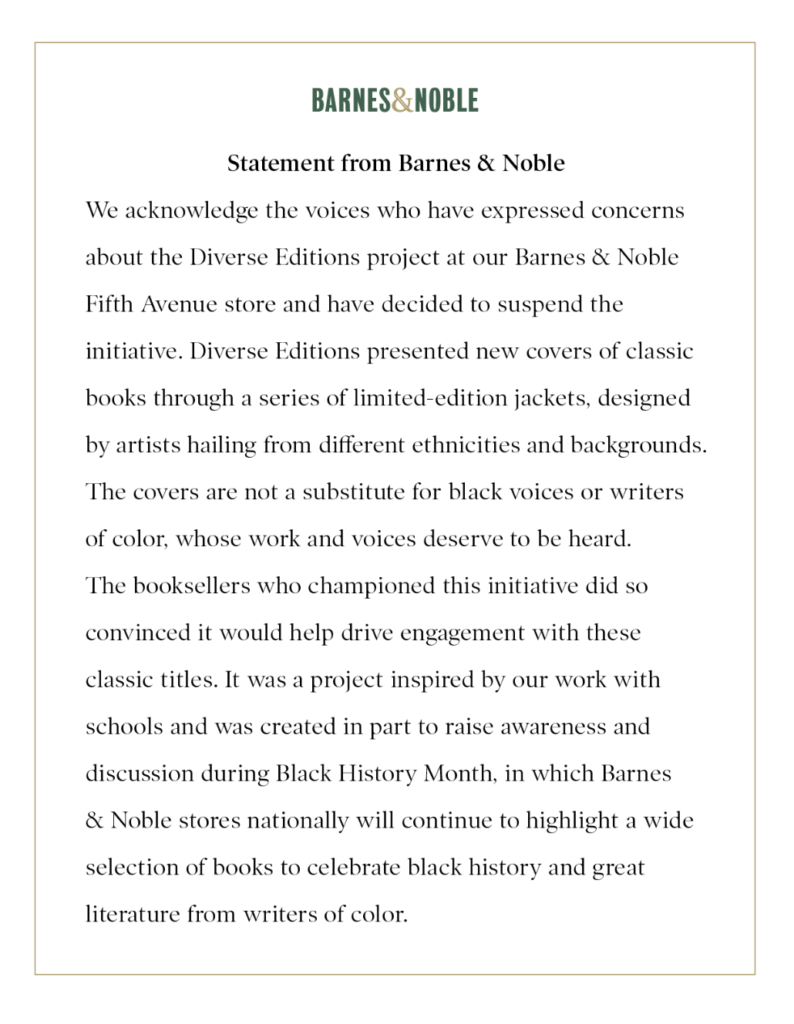
The classic books Barnes & Noble selected to feature are covered well in schools, in movies, and across the board. They have and continue to get a ton of engagement, as they are well known and have their place in history. Just not Black history.
Barnes & Noble missed the mark with their covers because it failed to advance the intended mission of what they were attempting to celebrate: the history, role, and accomplishments of Black Americans in U.S. history and culture.
If their goal was to drive engagement among Black readers with these classic titles, that’s fine. Just don’t do it in the name of Black History Month. Instead, seize the opportunity to promote Black authors and some of their classic works that don’t get enough engagement but deserve to.
Facebook fully embraced the principle of centering the Black community and culture with its 2020 Black History Month campaign. The social media giant created a video in which singers from various Facebook Groups, along with girl group June’s Diary, came together to perform a rendition of “Lift Every Voice and Sing,” the Black national anthem.
The song has sentimental value to me. I and so many others within the community grew up singing “Lift Every Voice and Sing,” and I appreciated Facebook for delivering a customer experience that beautifully captured such an important element of Black culture.
After watching the spot multiple times, I was inspired to send it to my family on a group text and posted it in a WhatsApp group I’m in.
Another thing Facebook got right with this campaign was that it made its customers, specifically African-Americans who use their Facebook Groups, the hero. Aside from the group June’s Diary, the spot used everyday people who use the groups feature on the platform to connect with each other.
By elevating members of the Black community, the commercial was more powerful. It felt genuine, real, and authentic. As an African-American, I felt seen, appreciated, and like I belonged. This is important for your brand because you always want your customers to feel they belong with you–that you see them and honor them.
A big way you can equip your team to do this for Black History Month and beyond is to stay close to the diverse communities you are highlighting. Spend time with them, build relationships, develop a deep degree of intimacy with them, and empathy for them. Embrace as much of the culture as you can, so you can find natural ways to incorporate the community into elements of your marketing without it feeling forced.
Principle #3: Co-create your campaigns with members of the Black community
When you partner with members who are part of the communities you serve, it takes the pressure off of you and your team to have all the ideas about how your brand should show up. It also showcases your greater commitment to serving the community over the long-term.
Also, the more you collaborate and partner with those who are members of the communities you want to engage with, the easier it will be to uncover insights that will help you speak to them in a way that draws them closer to you.
Target noted that they worked with their African-American Business Council, an employee resource group of more than 1,000 team members, to help them with the campaign. They helped them select which products should be a part of the collection, and coordinate events to help drive awareness, engagement, and celebration.
Target’s model of engaging with and collaborating with the group they wish to honor during their month-long celebration of cultural heritage and contributions went a long way toward helping them get their campaign right.
Over the past few years, Spotify has stepped up their game with their efforts celebrating Black History Month. For the past two years, they have featured their Black History Is Now music hub, which celebrates the music and achievements of African-Americans not just during Black History Month, but all year round.
In addition to working with employees, Spotify also partnered with prominent artists within the Black community. Those collaborations them strong insights into how to increase both the impact and the effectiveness of their campaigns.
I chatted with Amanda Butler, Spotify’s Director, Head of Music Marketing, to find out more about how their expansive culture-rich campaigns came to life.
“I think for us the biggest thing is that…we’ve worked with some really notable, incredible artists. Janelle Monáe, for us, was really about her using her voice to say that “our contribution to history and culture goes beyond the month of February and that it should be discussed all year round.” And then Pharrell Williams was really important to us as we work with creators and artists in general, that they use their voice and us using our resources to help amplify the message that they want to share.”
Ideally, people working on your marketing team, agencies, and consultants should be representative of the customers you serve. If that isn’t your reality today, tap into the employee resource groups at your company.
When I worked my corporate job, I was an active member of our employee resource group for African-Americans. We would have loved the opportunity to partner with brand teams on how to effectively engage with the Black community in marketing.
Don’t, however, just expect that your Black employees outside of resource groups should just take on such a project on a volunteer basis in addition to their daily work.
You can also partner with members, creators, and influencers of the Black community to help shape and collaborate on your campaign. These can be folks at a global, national, regional, and even local level.
With some creativity, you can find a mutually beneficial manner to make a collaboration work, no matter your budget.
Principle #4: Special edition products you launch shouldn’t feel opportunistic
It is ok for you to introduce new products to celebrate Black History Month, but again remember the goal is to celebrate, support, and uplift the Black community rather than to increase your bottom line. Otherwise, your efforts will feel opportunistic rather than genuine.
If you do introduce special edition products, be sure to ensure that it does one or more of the following: has a clear connection to Black history, is created by or promotes the work of Black creators or entrepreneurs, or that the proceeds go to support non-profit organizations whose work is focused on causes important to the Black community.
In 2019, Adidas introduced a new line of shoes in celebration of Black History Month with designs they noted were inspired by the Harlem Renaissance. Consumers quickly expressed their frustration with the brand, because they couldn’t figure out how one of the shoes in the collection, the one named “Celebrating Black Culture” Ultra Boost Uncaged, connected to Black history. Here’s are a couple of photos of the controversial shoe.



Adidas pulled the shoe in the collection after the uproar and released a statement explaining their decision.
“Adidas released a new collection in celebration of Black History Month featuring designs inspired by the Harlem Renaissance. It includes footwear and apparel across a variety of categories. Toward the latter stages of the design process, we added a running shoe to the collection that we later felt did not reflect the spirit or philosophy of how Adidas believes we should recognize and honor Black History Month. After careful consideration, we have decided to withdraw the product from the collection.”
If you’re going to celebrate a particular group, they have to feel like they are being celebrated. You can’t just slap a “Celebrating Black Culture” label on something — as was included on the inside of the Adidas shoe, and expect that people will feel a connection to it.
Your efforts have to go deeper if you want it to resonate with a particular community. Otherwise, it just looks like you are using a cultural celebration and the buzz surrounding it as an opportunity to launch a new product. Boo.
When Target featured products for their Black History Month celebration, they ensured they included products made by Black-owned businesses. In a blog on their website talking about their celebration, they noted:
“Throughout the month, Target is also shining a spotlight on products from Black-owned businesses that are carried in our stores year-round. One-third of Black History Month products are from Black-owned businesses…and more than half are exclusive to Target. This year’s Black History Month marketing campaign, Black Beyond Measure, also features Black entrepreneurs and Target team members. The campaign was designed to amplify success stories and celebrate Blackness, an uplifting sentiment to empower future generations.”
Over the years, Nike has also released special edition shoes and apparel for Black History Month. The shoes were most often editions of existing brand spokespersons, such as LeBron James, Kobe Bryant, and Kyrie Irving.
Also, proceeds from their Black History Month collections are donated to support numerous organizations that provide services to underrepresented youth, such as the Jackie Robinson Foundation, Boys and Girls Clubs, National Head Start, and Coach Across America.
Principle #5: Make it relevant to the masses
I’ve been to more Black History Month programs than I can count over the years that have been mainly put on by Black people for Black people. But the celebration of Black history isn’t only for those who are a part of the African diaspora. It is a part of our collective history. And the more we as a society shine a light on Black people’s achievements throughout history, the more we normalize Black achievement.
Lyft took the opportunity to make Black history accessible to everyone with their 2019 campaign. They offered free rides (up to $10 in value), to a Black history museum, memorial, or relevant cultural site throughout the U.S. and Canada during the month of February.
For their 2020 Black History Month campaign, Apple dedicated their Today at Apple Sessions, creative and educational workshops offered for free in Apple stores, to learning from Black creators. The workshop leaders included creators Apple felt were “changing cultural narratives through visual arts, photography, poetry, dance, film, and more.” The brand encouraged people to participate in the sessions to “connect, collaborate, and be inspired.”
Google’s “most searched” campaign educated the masses. And Facebook’s promotion featuring the song “Lift Every Voice and Sing” tapped into one group’s memories of an important part of their culture, while introducing it to others who were unfamiliar with it.
Principle #6: Make it relevant to the culture
“Black history isn’t only Martin Luther King, Jr., and Rosa Parks.” That’s what my sister said when I mentioned I was working on a project on this topic.
The reality is, so much of what we see and hear around Black history is centered on slavery and the civil rights movement. While the heroes that emerged from these periods are important to remember and celebrate, they are far from the only contributors to the story.
Thus as you work to create your Black History Month campaigns, expand your thinking about Black culture. To do that, you’ll have to be connected to Black culture.
One of the core tenets of persuasion and copywriting is to “enter the conversation already happening in your consumers’ head.” Leaning into this principle is essential to connect with diverse and niche communities in a way that feels authentic.
And to ensure your team is equipped to do that, they have to be immersed in the culture, enough to have a deep degree of intimacy with it, to know what those conversations are.
Spotify credits their success with their Black History Month campaigns to their connection to what is happening in Black culture. Here’s Amanda Butler again:
“In terms of why it’s important to Spotify, I think it’s actually being a member of culture and actually the intersection of music and how it impacts culture..when we think about what we’ve done with the Black History Is Now hub, where we’re highlighting things like Black Love Mixtape, Black Girl Magic, all these notable storylines are so fluidly connected in culture and speak to some of the topics that people are already naturally speaking. And, we started to see really great reaction in terms of coming to the site interacting with the music, talking about it, sharing with their friends.”
Don’t be a bystander to the culture you want to impact. Jump into it, learn it, support it, and elevate it. You’ll see a much greater return on your marketing efforts as a result.
Principle #7: Don’t limit your engagement with the Black community to one month
Engage all year long.
It’s kind of like only showing up to celebrate with your friend on their birthday, then disappearing for the rest of the year.
If you want to make a lasting impact and build deeper, more emotional relationships with Black consumers and other niches, you’ve got to show up consistently and be a part of the community. Celebrate the communities when everyone else is celebrating, yes, but stick around and continue to support all year long. Don’t just implement a Black History Month campaign, and then ghosting them.
When it comes to prioritizing inclusive marketing and regularly engaging with diverse and niche consumers, nobody expects you to be perfect on day one. Building relationships that allow you to serve and connect with these communities takes time and commitment.
Don’t feel like you have to swing for the fences as you get started.
Start small, learn, adjust, gain momentum, and expand over time.



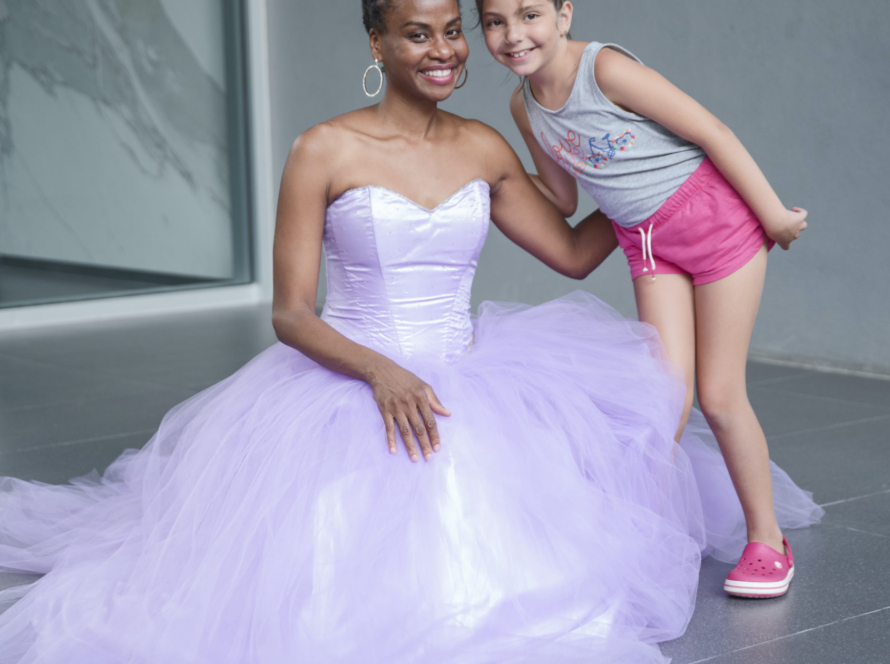

1 Comment
Jimmy Johnson
I totally agree with this article as it is intelligent and is meant to be helpful and informative. I find all seven principles important as a guide for any company wishing to celebrate Black History Month. This article has a clear intent to help bring people together through honor and acknowledgement of people who may look different from you. I have been very turned off by some ads that create division by citing individual instances where they are inferring racism. Such as a college professor admonishing another professor from Nigeria for not having better command of the English language. So there is one stupid professor! Should it take up a $250,000 dollar ad space? Especially when there are so many great Black Americans that we all should be aware of and celebrate. We already know the problem. Negative ads help no one and only creates more division. This article is a template for a positive change in healing our country’s division and and promotes awareness and sensitivity and a positive step in that direction. This article is part of the solution, not the problem.